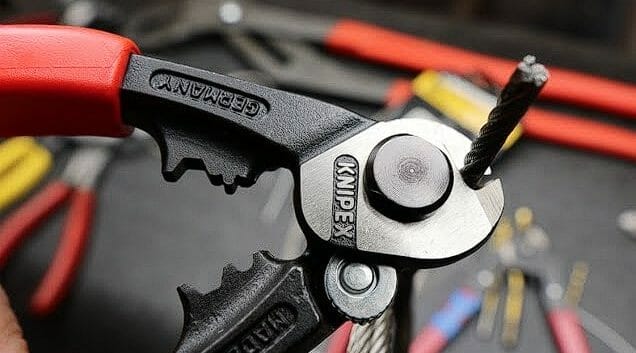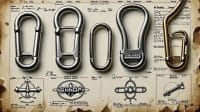When it comes to cutting stainless steel wire, using the correct technique is essential. This strong and durable metal can be difficult to cut without the right tools and know-how. In this guide, we will cover everything you need to know about cutting stainless steel wire, from understanding its properties to choosing the right cutting technique.
Key Takeaways
- The correct technique is essential for cutting stainless steel wire
- Stainless steel wire is strong, durable and resistant to corrosion
- Essential tools for cutting stainless steel wire include wire cutters, pliers and saws
- To achieve a smooth cut, it is important to prepare the wire properly and use the right technique
- Safety precautions should always be taken when cutting stainless steel wire
Understanding the Properties of Stainless Steel Wire
Stainless steel wire is known for its unique properties that make it a popular and versatile material used in a wide range of applications. Understanding these properties is essential in knowing how to cut and manipulate the wire properly.
One of the key properties of stainless steel wire is its strength. It is an incredibly durable material that can withstand high amounts of stress and pressure without breaking or deforming. This makes it perfect for use in applications that require reliable and long-lasting products.
Another crucial property of stainless steel wire is its corrosion resistance. Unlike other metals, it does not rust or corrode when exposed to moisture or harsh environmental conditions. This makes it an ideal choice for outdoor or marine applications.
Stainless steel wire is also very malleable, which means it can be easily shaped and formed into various configurations. This makes it a popular choice for use in jewelry and other decorative applications.
Overall, stainless steel wire is a versatile, durable, and corrosion-resistant material with a wide range of applications. Its unique properties make it a preferred choice for many different industries and DIY projects.
Tools and Equipment for Cutting Stainless Steel Wire

Before you start cutting stainless steel wire, it is important to have the right tools and equipment. Using the wrong tools can lead to a less-than-perfect cut and even damage to your wire. Here are some essential tools and equipment you will need:
| Tool/Equipment | Description |
|---|---|
| Wire cutters | Designed specifically for cutting wire, with sharp edges for a clean cut. |
| Pliers | Useful for gripping the wire and holding it in place, especially when attempting more intricate cuts. |
| Saws | A hacksaw or band saw can be used for cutting thicker wires, but be sure to choose one with blades designed for stainless steel. |
| Plasma cutter | A high-tech option that uses a plasma torch to cut the wire. This tool provides precise cuts and is highly recommended for larger projects. |
It’s important to note that not all tools are created equal. When choosing your tools and equipment, it is important to invest in ones that are designed specifically for cutting stainless steel wire. Cheaper tools made for cutting other materials may be inadequate and can lead to damage to the wire.
When it comes to wire cutters, be sure to choose one with sharp edges. Dull edges can cause the wire to fray or bend, leading to an imperfect cut. For thicker wires, a saw may be necessary. Choose a saw with blades designed for cutting stainless steel wire.
For larger projects or more intricate cuts, a plasma cutter may be the way to go. These high-tech tools use a plasma torch to precisely cut the wire, making them an excellent option when working with larger pieces of stainless steel wire.
Investing in high-quality tools and equipment from the outset can save you time and money in the long run, as well as ensure that your cuts are clean and precise.
Preparing the Stainless Steel Wire for Cutting

Before cutting stainless steel wire, it is important to properly prepare the wire to ensure a clean and precise cut. Here are some steps you can take:
- Clean the wire: Before cutting, make sure the wire is free from any dirt, grease, or other contaminants that could affect the cut quality. You can clean the wire using a degreaser or rubbing alcohol.
- Straighten the wire: Bent or kinked wire can be difficult to cut and can result in an uneven cut. Use pliers or a wire straightener to gently straighten the wire before cutting.
- Securely hold the wire: When cutting the wire, it should be held firmly in place to prevent it from moving or vibrating. Use a vise or clamps to secure the wire in position.
By following these simple steps, you can ensure that your stainless steel wire is properly prepared for cutting and that you achieve a clean, precise cut every time.
Choosing the Right Cutting Technique
When it comes to cutting stainless steel wire, there are a few different techniques you can use, each with its own benefits and drawbacks. Here are some of the most common methods:
- Wire cutters: These are the most straightforward tools for cutting stainless steel wire. They work by using sharp blades to snip through the wire. Wire cutters are convenient and easy to use, but they may not be suitable for thicker or denser wire.
- Sawing: If you need to cut thicker wire, a saw may be a better option. However, sawing requires a bit more time and effort than using wire cutters. Make sure you choose a saw blade specifically designed for cutting stainless steel.
- Plasma cutter: A plasma cutter is a high-tech tool that uses an electrically conductive gas to cut through metal. While it may be overkill for simple wire-cutting tasks, a plasma cutter can be very effective for cutting thick or complex shapes out of stainless steel wire. However, plasma cutters can be expensive and require some training to use safely.
Ultimately, the right cutting technique for you will depend on the thickness and type of wire you’re working with, as well as your level of experience and available tools.
Here are some additional tips for choosing the right cutting technique:
- Consider the precision required for your task. Wire cutters are best for simple cuts, while sawing or plasma cutting may be better for more complex shapes.
- Think about the workspace available to you. If you’re working in a small or cramped space, a plasma cutter may not be practical.
- Consider the noise and fumes associated with different cutting techniques. Sawing and plasma cutting can both be loud and produce a lot of fumes, so make sure you’re working in a well-ventilated area.
- Be aware of the safety risks associated with each technique. Plasma cutters, for example, produce intense heat and can be dangerous if not used correctly.
By taking these factors into account and choosing the right cutting technique for your needs, you can ensure a smooth and efficient cutting process.
Tips for Achieving a Smooth Cut
When cutting stainless steel wire, achieving a smooth cut is essential to ensure a professional and polished finish. Here are some practical tips to help you achieve a smooth cut:
- Use the Right Tool: Using the correct tool for cutting stainless steel wire is critical. Wire cutters, pliers, and saws are all viable options. Choose the tool that is appropriate for the thickness of the wire you are cutting.
- Maintain Steady Pressure: When cutting the wire, it’s important to maintain steady pressure. This helps prevent the wire from twisting or turning while you’re cutting, which can result in an uneven cut.
- Clean the Wire: Before cutting, make sure the stainless steel wire is clean and free from any debris or oil. Any contamination on the wire can cause the cutting tool to slip, resulting in an uneven cut.
- Straighten the Wire: Straightening the wire before cutting is essential to ensure a smooth and straight cut. Use pliers to straighten the wire if it is bent or curled.
- Secure the Wire: Make sure the wire is securely held in place before cutting. This helps prevent the wire from moving or vibrating during the cut, which can result in an uneven finish.
- Avoid Common Mistakes: Avoid common mistakes such as using dull cutting tools, not applying enough pressure, or cutting too quickly. These mistakes can result in an uneven cut and can damage the cutting tool.
By following these tips, you can ensure that you achieve a smooth and professional cut when cutting stainless steel wire. Remember, always prioritize safety and use the correct techniques and tools for the job.
Can I Weld Stainless Steel with Flux Core Wire?

Many DIY enthusiasts wonder if they can weld stainless steel with flux core wire, but the short answer is no. While flux core welding is a popular and effective technique, it is not suitable for welding stainless steel wire.
Flux core welding involves using a hollow wire that is filled with flux, a substance that helps to protect the weld from oxidation and other forms of contamination. However, this process is not ideal for welding stainless steel wire because the material is highly resistant to oxidation and requires a more specialized welding technique.
Instead of using flux core wire, it is recommended to use a gas shielded welding technique, such as TIG or MIG welding. These methods use a shielding gas to protect the welding area from oxidation and produce a cleaner, stronger weld.
While it may be tempting to try using flux core wire for welding stainless steel, it is important to use the correct welding technique to ensure a safe and effective result. Always follow recommended safety guidelines when welding and work with a qualified professional if you are unsure about the process.
Safety Precautions When Cutting Stainless Steel Wire
Working with stainless steel wire requires extra caution to ensure the safety of the operator and those nearby. Before beginning any cutting, make sure to follow these safety precautions:
- Always wear protective gear, including gloves, safety glasses, and a face shield, to protect against flying debris and sparks.
- Ensure the work area is well-ventilated to prevent inhaling harmful fumes.
- Avoid wearing loose clothing that could get caught in the cutting equipment.
- Use clamps or a vice to securely hold the wire in place to prevent it from moving during the cutting process.
- Make sure the cutting tools are in good condition and properly maintained before use.
- Double-check that the cutting tools are suitable for cutting stainless steel wire and are used properly, as using the wrong tool may cause injury or damage the wire.
- Be cautious and patient when cutting to prevent forcing or bending the wire, which can create dangerous situations such as snapping or flying debris.
By following these safety precautions, operators can effectively reduce the risk of accidents when working with stainless steel wire. Remember to prioritize safety, as it is the key to a successful and safe cutting experience.
Conclusion
Now that you know the correct methods and techniques for cutting stainless steel wire, you can tackle your next project with confidence. Remember to always use the proper tools and equipment, and take the time to prepare the wire before cutting. Choosing the right cutting technique and following safety precautions are also essential for achieving a smooth and successful cut.
Whether you are working on a DIY project or a professional job, cutting stainless steel wire requires attention to detail and the use of correct techniques. With the tips and information provided in this article, you can cut stainless steel wire like a pro and achieve the results you desire.
So go ahead and put your new knowledge to the test. Grab your wire cutters, pliers, or saws, and get cutting!
Read More : Can I Weld Stainless Steel With Flux Core Wire? Find Out!
Which Finish (2B or 4) is Recommended for Cutting Stainless Steel Wire?
When it comes to cutting stainless steel wire, choosing the right finish is crucial. In this case, we have two options: stainless steel finishes: 2b vs 4 a comparison. The 2B finish is the most common, offering a smooth surface and adequate corrosion resistance. On the other hand, the 4 finish is more polished, making it ideal for decorative applications. Ultimately, the recommended finish will depend on the specific requirements of the cutting task.
What Are the Best Techniques for Cutting Stainless Steel Wire?
When it comes to cutting stainless steel pipes, there are several effective techniques to choose from. One commonly used method is using a power saw with a dedicated stainless steel blade. Another option is using a grinder with a cutting disc specifically designed for stainless steel. Additionally, plasma cutting and waterjet cutting are popular techniques for precise and clean cuts on stainless steel pipes. Ultimately, the best technique depends on the specific requirements of the project and the available tools.
FAQ
Q: What is the correct way to cut stainless steel wire?
A: The correct way to cut stainless steel wire is to use specialized tools such as wire cutters, pliers, or saws. It is important to ensure the wire is properly cleaned, straightened, and securely held in place before cutting.
Q: What are the properties of stainless steel wire?
A: Stainless steel wire is known for its strength, corrosion resistance, and durability. It is a versatile material that is commonly used in various industries.
Q: What tools and equipment do I need for cutting stainless steel wire?
A: To cut stainless steel wire, you will need tools such as wire cutters, pliers, and saws. It is recommended to use high-quality tools that are specifically designed for cutting stainless steel.
Q: How should I prepare the stainless steel wire before cutting?
A: Before cutting stainless steel wire, it is important to clean the wire, straighten it, and ensure it is securely held in place. This will help ensure a clean and precise cut.
Q: What are the different cutting techniques for stainless steel wire?
A: There are various cutting techniques for stainless steel wire, including using wire cutters, sawing, or using a plasma cutter. Each method has its advantages and disadvantages, so it is important to choose the technique that best suits your needs.
Q: How can I achieve a smooth cut when cutting stainless steel wire?
A: To achieve a smooth cut when cutting stainless steel wire, it is important to maintain steady pressure, use the right tool for the job, and avoid common mistakes such as applying too much force or using a dull blade.
Q: Can I weld stainless steel with flux core wire?
A: It is not recommended to weld stainless steel with flux core wire. Flux core welding is generally used for carbon steel and may not provide the desired results for stainless steel. There are alternative methods available for welding stainless steel wire.
Q: What safety precautions should I take when cutting stainless steel wire?
A: When cutting stainless steel wire, it is important to wear protective gear such as gloves and safety glasses. Additionally, it is recommended to work in a well-ventilated area and follow proper handling and disposal procedures for any metal scraps.






